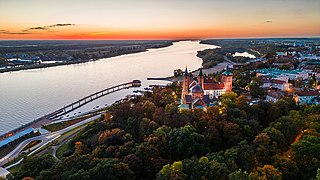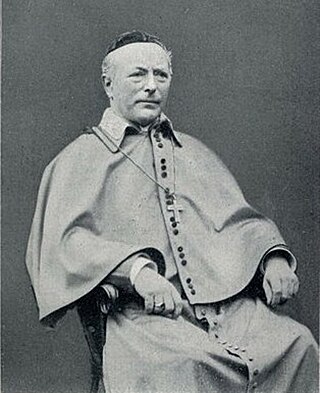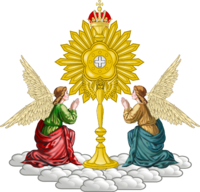The terms Old Catholic Church, Old Catholics, Old-Catholic churches, or Old Catholic movement, designate "any of the groups of Western Christians who believe themselves to maintain in complete loyalty the doctrine and traditions of the undivided church but who separated from the see of Rome after the First Vatican council of 1869–70".

Płock is a city in central Poland, on the Vistula river, in the Masovian Voivodeship. According to the data provided by GUS on 31 December 2021, there were 116,962 inhabitants in the city. Its full ceremonial name, according to the preamble to the City Statute, is Stołeczne Książęce Miasto Płock. It is used in ceremonial documents as well as for preserving an old tradition.

The Old Catholic Mariavite Church refers to one of two independent Christian churches, both of which can be dated from 1906 but which became distinct after 1935 as a result of doctrinal differences, and are collectively known as Mariavites. Mariavitism first emerged from the religious inspiration of Polish noblewoman and nun Feliksa Kozłowska (1862–1921) living in the Russian Partition of Poland in the late 19th-century. A young Catholic priest from a modest background, Jan Maria Michał Kowalski (1871–1942), became convinced by Kozłowska's revelations and adopted her vision as his own project by her side.

The Temple of Mercy and Charity is a Mariavite cathedral in Płock in central Poland. It is located near the Vistula River.

Feliksa Magdalena Kozłowska, known by the religious name Maria Franciszka and the epithet "Mateczka", was a Polish religious sister, Christian mystic and visionary who founded a movement of renewal in the Roman Catholic church in the Russian Partition of Poland. It was to follow the simplicity of the life of Mary, mother of Jesus. Early in the 20th century, she and this movement were excommunicated and became an autonomous church in fellowship with the Old Catholic Church of the Netherlands. In 1935 it split in two and became the Old Catholic Mariavite Church and the Catholic Mariavite Church. Both denominations were part of a single schism from the Catholic Church which declared it as heretical in 1906.
Independent Catholicism is an independent sacramental movement of clergy and laity who self-identify as Catholic and form "micro-churches claiming apostolic succession and valid sacraments", in spite of not being affiliated to the historic Catholic church, the Roman Catholic church. The term "Independent Catholic" derives from the fact that "these denominations affirm both their belonging to the Catholic tradition as well as their independence from Rome".

The Congregation of Marian Fathers of the Immaculate Conception of the Most Blessed Virgin Mary is a Catholic male clerical religious congregation founded, 1670, in Poland. It is also known as Marians of the Immaculate Conception. Its members add the post-nominal letters M.I.C. after their names to indicate membership in the Congregation.
Hilarios Karl-Heinz Ungerer is a bishop of the Free Catholic Church in Munich, a small Independent Catholic denomination. Ungerer, with Bishop Roberto Garrido Padin, ordained Bishop Rómulo Antonio Braschi in 1998, who ordained a group of women known as the Danube Seven in 2002.

The 108 Martyrs of World War II, known also as the 108 Blessed Polish Martyrs, were Catholics from Poland killed during World War II by Nazi Germany.

Jan Kowalski, later known as Maria Michał Kowalski, was a Polish Roman Catholic diocesan priest who became a schismatic religious leader and controversial innovator. Following excommunication from his church, he was consecrated as a bishop in the Old Catholic Archdiocese of Utrecht, established the Old Catholic Church of the Mariavites in Poland, rose to be its archbishop and died a martyr. He is venerated as a saint in the Catholic Mariavite Church.
Tribus circiter is Pope Pius X's 1906 encyclical, to the archbishops of Warsaw and bishops of Płock and Lublin, about the Mariavites or Mystic Priests of Poland, an association of secular priests that the document describes as "a kind of pseudo-monastic society". The association of secular priests and the Mariavite movement was founded by Feliksa Kozłowska and later broke away from the Catholic Church to become the Mariavite Church.

Gerardus Gul served as the seventeenth Archbishop of Utrecht from 1892 to 1920. He is known for his role in assisting the persons who would later found the Polish National Catholic Church in the United States, as well as for consecrating Arnold Harris Mathew, the founder and first bishop of the Old Catholic Church in Great Britain.

Maria Faustyna Kowalska of the Blessed Sacrament, OLM was a Polish Catholic religious sister and mystic. Faustyna, popularly spelled "Faustina", had apparitions of Jesus Christ which inspired the Catholic devotion to the Divine Mercy, therefore she is sometimes called the "secretary" of Divine Mercy.

The Priest Barracks of Dachau Concentration incarcerated clergy who had opposed the Nazi regime of Adolf Hitler. From December 1940, Berlin ordered the transfer of clerical prisoners held at other camps, and Dachau became the centre for imprisonment of clergymen. Of a total of 2,720 clerics recorded as imprisoned at Dachau some 2,579 were Roman Catholics. Among the other denominations, there were 109 Protestants, 22 Orthodox, 8 Old Catholics and Mariavites and 2 Muslims. Members of the Catholic Society of Jesus (Jesuits) were the largest group among the incarcerated clergy at Dachau.
Stephen Kaminski was the bishop of an independent Christian diocese known as the Polish Independent Catholic Church of America. He is considered to have been an episcopus vagans.

Antonina Maria Izabela Wiłucka-Kowalska was a Polish religious leader, who served as the first archpriestess of the Catholic Mariavite Church. Wiłucka-Kowalska was the first woman to receive the sacrament of holy orders in Poland and consecration as a bishop.
Mariavite Sisters may refer to:

Roman Maria Jakub Próchniewski was the Prime Bishop of the Mariavite Old Catholic Church from 1945 to 1953.

Julian Pękala was the Primate Bishop of the Polish Catholic Church from 1951 to 1959 as president of the episcopal college, and Primate Bishop from 1965 to 1975. From 1951 to 1959, he was the parish priest of the Cathedral Parish of the Holy Spirit in Warsaw. From March 23, 1961, to October 29, 1965, he served as the bishop ordinary of the Wrocław diocese of the Polish Catholic Church.
















